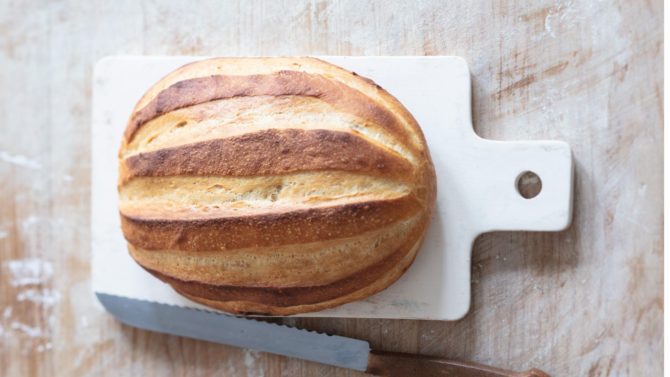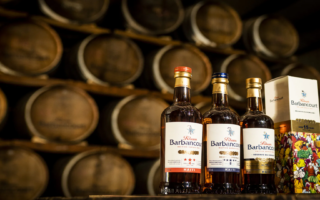French recipe: How to make pain brié
Learn how to make this traditional Normandy bread from Upper Crust: Homemade Bread the French Way
Expand your French bread-making skills by making a pain brié. This attractive loaf is a Normandy favourite and is nothing to do with the cheese, brie! Its name actually comes from the old Norman verb brier, which means ‘to pound’. The result is a tight-crumbed treat traditionally given to fishermen to keep them full during the working day. It hails from the north of the region, specifically the Bessin area, where you’ll find towns like Bayeux and Isigny-sur-Mer.
This recipe is extracted from Upper Crust: Homemade Bread the French Way by Marie-Laure Fréchet (Flammarion, 2021). Bon appétit!

Makes 1 loaf
Active time: 20 minutes
Poolish: 2 hours
Bulk fermentation: 30 minutes
Proofing: 1 hour
Chilling: 10–15 minutes
Cooking: 20–25 minutes
EQUIPMENT
- Bread peel
INGREDIENTS
Poolish
- ⅔ cup (5.25 oz./150 g) water
- 0.07 oz. (2 g) fresh yeast
- 1 cup + 2 tbsp (5.25 oz./150 g) all-purpose flour (T55)
Bread
- 5 tsp (1 oz./25 g) water
- 0.1 oz. (3 g) fresh yeast
- ¾ cup + 2 tbsp (3.5 oz./100 g) all-purpose flour (T55)
- 1 tbsp (0.75 oz./20 g) butter, at room temperature
- 1 tsp (0.2 oz./5 g) salt
METHOD
Prepare the poolish: Heat the water to about 77°F (25°C). Place in a medium bowl, add the yeast, and stir or swish to dissolve. Stir in the flour until just combined. Cover and let sit at room temperature for about 2 hours, until bubbly on top.
Prepare the bread: Place the 5 tsp (1 oz./25 g) water in the bowl of a stand mixer fitted with the dough hook and crumble in the fresh yeast. Mix to dissolve the yeast, then add the poolish, flour, butter, and salt.
Knead for 3 minutes on speed 1, followed by 3–5 minutes on speed 2. Cover and let rest at room temperature for about 30 minutes (bulk fermentation).
Turn the dough out onto a floured work surface and shape it into a ball or a very short bâtard. Cover and let rise for 1 hour (proofing).
Meanwhile, place a rack at the lowest oven position and place another rack directly above it. Place an empty heavy-duty baking sheet, oven-safe skillet, or drip pan on the lower rack, and a baking stone or heavy-duty baking sheet on the upper rack, and preheat the oven to 450°F (230°C/Gas Mark 8). Bring 1 cup (250 ml) of water to a simmer.
At the end of proofing, refrigerate the dough for 10–15 minutes to firm it up before baking.
When the dough passes the poke test (see below), remove it from the refrigerator and place it on the floured peel. Holding a lame at a slight angle, make three to five quick parallel slits, about ¼ in. (5 mm) deep, from one end of the dough to the other.
Slide the dough onto the baking stone or sheet. Carefully pour the hot water into the skillet to create steam and quickly close the oven door. Bake for 20–25 minutes, until deeply golden. Toward the end of the baking time, crack the oven door open for 5–10 minutes to lower the temperature and encourage the bread to develop a thick crust.
Remove the bread from the oven and place it on a rack to cool.
POKE TEST
If the proofing time is too short, the dough won’t build up enough CO2 to rise correctly during baking. Conversely, if the proofing time is too long, the gluten network weakens and the bread may fall during baking. Even professional bakers use the poke test to evaluate the dough’s resistance and determine when it is ready for the oven. Gently press your finger about ½ in. (1 cm) into the dough. If the dough is ready to bake, it will spring back slowly but retain a small indentation where you poked it. If no indentation forms, the dough is not ready; leave it to proof a little longer. If the indentation doesn’t spring back at all, it’s too late—the dough is over-proofed.
Share to: Facebook Twitter LinkedIn Email
More in French food, French recipes




